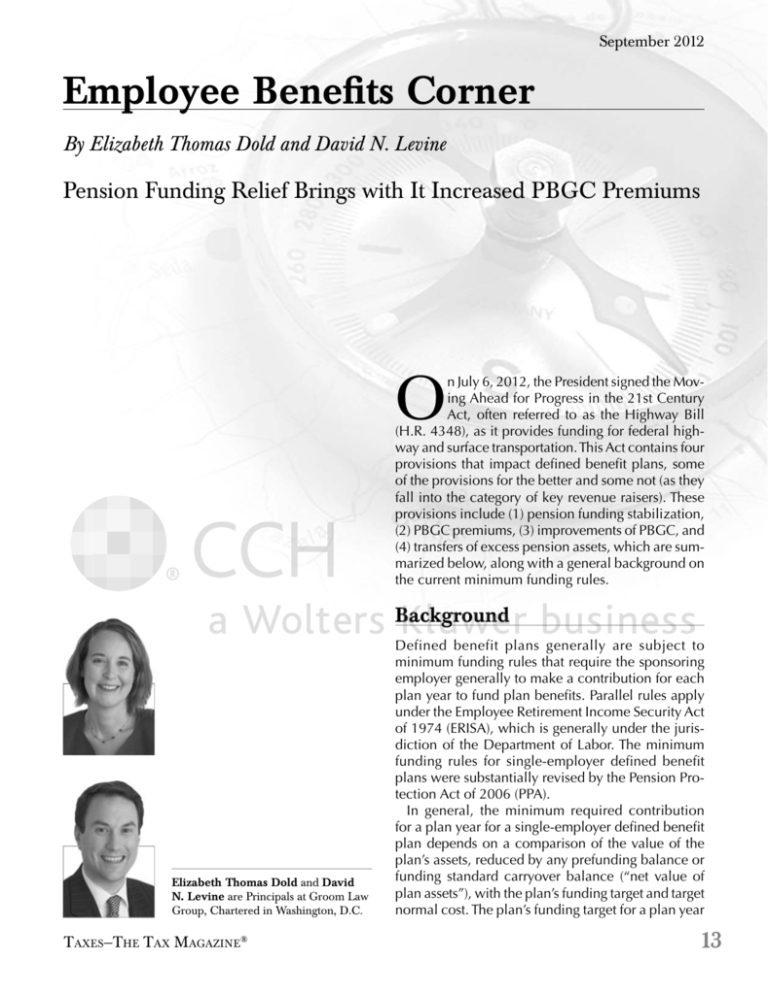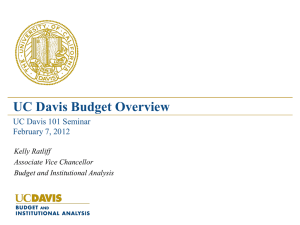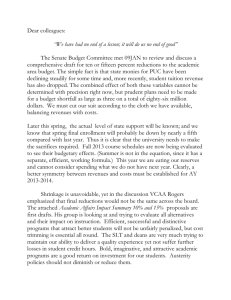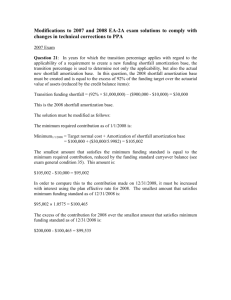
September 2012
Employee Benefits Corner
By Elizabeth Thomas Dold and David N. Levine
Pension Funding Relief Brings with It Increased PBGC Premiums
O
n July 6, 2012, the President signed the Moving Ahead for Progress in the 21st Century
Act, often referred to as the Highway Bill
(H.R. 4348), as it provides funding for federal highway and surface transportation. This Act contains four
provisions that impact defined benefit plans, some
of the provisions for the better and some not (as they
fall into the category of key revenue raisers). These
provisions include (1) pension funding stabilization,
(2) PBGC premiums, (3) improvements of PBGC, and
(4) transfers of excess pension assets, which are summarized below, along with a general background on
the current minimum funding rules.
Background
Back
kgr
groun
nd
Elizabeth Thomas Dold and David
N. Levine are Principals at Groom Law
Group, Chartered in Washington, D.C.
TAXES—THE TAX MAGAZINE®
Defined benefit plans generally are subject to
minimum funding rules that require the sponsoring
employer generally to make a contribution for each
plan year to fund plan benefits. Parallel rules apply
under the Employee Retirement Income Security Act
of 1974 (ERISA), which is generally under the jurisdiction of the Department of Labor. The minimum
funding rules for single-employer defined benefit
plans were substantially revised by the Pension Protection Act of 2006 (PPA).
In general, the minimum required contribution
for a plan year for a single-employer defined benefit
plan depends on a comparison of the value of the
plan’s assets, reduced by any prefunding balance or
funding standard carryover balance (“net value of
plan assets”), with the plan’s funding target and target
normal cost. The plan’s funding target for a plan year
13
Employee Benefits Corner
Alternatively, if the net value of plan assets is equal
is the present value of all benefits accrued or earned
to or exceeds the plan’s funding target, the minimum
as of the beginning of the plan year. A plan’s target
required contribution is the plan’s target normal cost,
normal cost for a plan year is generally the present
reduced by the amount, if any, by which the net value
value of benefits expected to accrue or to be earned
of plan assets exceeds the plan’s funding target. And
during the plan year.
any shortfall amortization bases and related shortfall
If the net value of plan assets is less than the plan’s
amortization installments are eliminated.
funding target, then the plan has a funding shortfall,
Lastly, it is important to understand the interest
and the minimum required contribution is the sum
rate assumptions to be used for determining the
of the plan’s target normal cost and the “shortfall
present value of benefits for purposes of a plan’s
amortization charge” for the plan year. The shortfall
target normal cost and funding target. Present value
amortization charge for a plan year is the sum of the
is determined using three interest rates (“segment”
annual shortfall amortization installments attributrates), each of which applies to benefit payments
able to the shortfall bases for that plan year and the
expected to be made from the plan during a certain
six previous plan years. Generally, if a plan has a
period. The first segment rate applies to benefits
funding shortfall for the plan year, a shortfall amorreasonably determined to be payable during the
tization base must be established for the plan year.
fi ve-year period beginA plan’s funding shortfall
ning on the first day of
is the amount by which
the plan’s funding target
The Act provides for much needed the plan year; the second
segment rate applies to
exceeds the net value of
funding relief for single-employer
benefi ts reasonably deplan assets. The shortfall
termined to be payable
amortization base for a
defined benefit plans.
during the 15-year peplan year is (1) the plan’s
riod following the initial
funding shortfall, minus
five-year period; and the third segment rate applies
(2) the present value, determined using the segment
to benefits reasonably determined to be payable at
interest
rates
restt rat
es (discussed below), of the aggregate
the end of the 15-year period. Each segment rate
total
amortization installments that
ta
all off the
he shortfall
sho
hor
is a single interest rate determined monthly by
have
ave been
beeen determined
detterm
ter
d for the
t e plan year and
an any
the Secretary of the Treasury (“Secretary”) on the
succeeding
respect
to any shortfall
uccceed
dingg plan
plaan year with
p
w
es
sh
basis of a corporate bond yield curve, taking into
amortization
sixx previous
mo
ortizzatio
on bases
bases forr the si
previous plan years.
account only the portion of the yield curve based
The sho
shortfall
hortfa
tf ll amortization
amorti
t
on base
bas is amortized
am ti d in
i level
on corporate bonds maturing during the particuannual installments
(“shortfall amortization installi
lar
corporate
bond
ments”) over a seven-yearr period
p od
d beginning
beginn ng with
w thee
ar segment
segment ratee period.
perio The
The co
orporate bon
d yyield
iel
curve
current plan year and using
ng the
t segment
egm nt interest
interest rates.
rate .
urve used
used for this
this purpose
pu ose reflects
ect the
the average,
average, for
fo
the 24-month period ending with the preceding
The shortfall amortization base for a plan year may
month, of yields on investment grade corporate
be positive or negative, depending on whether the
bonds with varying maturities and that are in the
present value of remaining installments with respect
top three quality levels available. The IRS publishes
to amortization bases for previous years is more or
the segment rates each month. The present value
less than the plan’s funding shortfall. If the shortfall
of liabilities under a plan is determined using the
amortization base is positive (that is, the funding
segment rates for the “applicable month” for the
shortfall exceeds the present value of the remainplan year. The applicable month is the month that
ing installments), the related shortfall amortization
includes the plan’s valuation date for the plan year,
installments are positive. If the shortfall amortization
or, at the election of the employer, any of the four
base is negative, the related shortfall amortization
months preceding the month that includes the
installments are negative. The positive and negative
valuation date.
shortfall amortization installments for a particular
Solely for purposes of determining minimum replan year are netted when adding them up in deterquired contributions, in lieu of the segment rates
mining the shortfall amortization charge for the plan
described above, an employer may elect to use
year, but the resulting shortfall amortization charge
interest rates on a yield curve based on the yields
cannot be less than zero (i.e., negative amortization
on investment grade corporate bonds for the month
installments may not offset normal cost).
14
©2012 CCH. All Rights Reserved.
September 2012
preceding the month in which the plan year begins
(i.e., without regard to the 24-month averaging described above) (“monthly yield curve”). If an election
to use a monthly yield curve is made, it cannot be
revoked without IRS approval.1
Funding Relief Provisions
The New Rules
The Act provides for much needed funding relief
for single-employer defined benefit plans. Changes
were made to the PPA’s minimum funding rules
under Code Sec. 430, briefl y described above,
and funding-based benefit restrictions provisions
under Code Sec. 436 to adjust for periods of abnormally low or extremely high interest rates so
as to remove the distortions caused by the current
low interest rate environment. In sum, the Act
increases the interest rates at which the minimum
funding rules and related actuarial certifications are
determined, resulting in much-needed decreases
to these liabilities and providing plan sponsor with
more flexibility in terms of plan contributions. Specifically, the Act adjusts the relevant interest rates
under these Code provisions for any period to the
extent
ent thatt the rate for that period is not within a
specifi
rates for
pecifi
ified
ed range
raangee of the average “segment”
g
the
he preceding
preeced
ding 25-year
2
ar period.
period. If a segment
segmen rate
for
under
is
or an applicable
app
pp
p abl month
plica
o
nd the PPA rules
ru
less
than
the
minimum
percentage,
esss tha
an th
he aapplicable
pp
plic ble min
mum p
ercentag the
segment
rate
match
that permen
nt ra
ate
t iis adjusted
dj
d upward
p rd to m
t h th
centage. Iff a segment rate for an applicable month
under the PPA rules is mo
more
e tthan
han the aapplicable
pp icablee
maximum percentage, the
he segment
ment rate is adjusted
ad
djusted
downward to match that percentage. The following
ranges would apply. For this purpose, the average
segment rate is the average of the segment rates
determined under the regular rules for the 25-year
period ending September 30 of the calendar year
preceding the calendar year in which the plan year
begins. The Secretary is to determine average seg-
Table 1.
If the calendar
year is
The applicable
minimum percentage is
The applicable
maximum percentage is
2012
90 percent
110 percent
2013
85 percent
115 percent
2014
80 percent
120 percent
2015
75 percent
125 percent
2016 or later
70 percent
130 percent
TAXES—THE TAX MAGAZINE®
ment rates on an annual basis and may prescribe
equivalent rates for any years in the 25-year period
for which segment rates determined under the regular rules are not available. The Secretary is directed
to publish the average segment rates each month,
which has not yet been released.
The applicable minimum percentage and the
applicable maximum percentage depend on the calendar year in which the plan year begins as shown
by Table 1.
For example, if the first segment rate determined for
an applicable month under the regular rules for the
2012 plan year is less than 90 percent of the average
segment rate, then the segment rate is adjusted to 90
percent of the average segment rate.
Certain additional information is required to be
included in the annual funding notice of an applicable plan year, and the DOL is directed to modify
the model funding notice to reflect this information.
Specifically, for an “applicable plan year,” the funding
notice should include the following:
A statement that the Act modified the method for
determining the interest rates used to determine
the actuarial value of benefits earned under the
plan, providing for a 25-year average of interest
rates to be taken into account in addition to a
two-year average
A statement that, as a result of the Act, the plan
sponsor may contribute less money to the plan
when interest rates are at historic lows
A table that shows (determined both with and
without regard to the Act) the funding target attainment
ainment percentage,
percentag the funding
fundin shortfall,
shortfall, and
and the
th
minimum
required
forr the ap
applicable
m
mi
nim m re
qui e contribution
ontr but on fo
plicab
plan year and each of the two preceding plan years
(For pre-2012 plan years, the table will show only
amounts determined without regard to the Act.)
For this purpose, the “applicable plan year” means
for any plan year beginning after December 31, 2011,
and before January 1, 2015, for which (1) the funding
target is less than 95 percent of such funding target
determined without regard to the Act, (2) the plan has
a funding shortfall (determined without regard to the
Act) greater than $500,000, and (3) the plan had 50
or more participants (following the aggregation rules)
on any day during the preceding plan year.
Rules That Did Not Change
Importantly, these funding changes do not apply to a
variety of related areas. For example, the Act changes
have no impact on the following rules:
15
Employee Benefits Corner
The maximum interest rates used for calculating
lump-sum (and other nonannuity) payouts under
Code Sec. 417(e)
The interest rate used for calculating maximum
lump-sum (and other nonannuity) payouts under
Code Sec. 415(b)
The limits on deductible employer contributions
under Code Sec. 404
ERISA §4006—calculation of variable rate PBGC
premiums
ERISA §4010—PBGC reporting (e.g., the $15M
underfunding provisions and 80-percent test)
Effective Date
These new rules apply for plan years beginning
after December 31, 2011, i.e., the 2012 plan
year. Importantly, a plan sponsor can elect to
defer these rules until the 2013 (presumably,
pending IRS guidance will inform us how to make
the election), and such an election comes with
anti-cutback protection. The employer can either
elect to defer (1) all these Act rules until the 2013
plan year, or (2) only the Act’s rules regarding the
Code Sec. 436 provisions—i.e., defer solely for
purposes of determining the plan’s adjusted funding target
percentage used in applying
targ
get attainment
aatta
thee funding-based
f d
fund
di g-ba
ding
base benefit restrictions in Code Sec.
436/ERISA
§206(g),
have the Ac
Act rules re
regard36
6/ERISA §20
06( and
nd hav
ing
minimum
funding
ngg min
nimu
um fu
g contributions
ib
under Code
Sec.
430
apply.
ec. 43
30 to
o ap
pplyy.
In
to ren addition,
add
dd
ditio
diti
on, the
t e Act
A permits
permit plan sponsors
s
voke a previous election (without IRS consent) to
use a monthly yield curve
rve to determine
deteerm
mine minimum
minimum
m
required contribution, but such
election
must
ch an ele
ction m
u t
be made within one year of the date of enactment
(which was July 6, 2012), and this election will not
prevent a plan sponsor from later switching back to
the monthly yield curve.
PBGC Premium Increases
The Act also substantially increases the PBGC premiums for single-employer plans, with a more modest
increase for multiemployer plans, beginning in 2013.
The rate changes are summarized below, which may
cause plan sponsors to reconsider terminating frozen
plans. Historically, the per-participant rate for flat-rate
premium ranged from $31 in 2007 to $35 in 2012
for single employer plans, and $8 in 2007 to $9 in
2012 for multiemployer plans.
Single-employer plans (please refer to Table 2)
Multiemployer plans: Flat-rate premiums will
increase from $9 to $12 per participant for plan
years beginning in 2013 and will be indexed to
inflation thereafter.
PBGC Structural Changes
The Act will also impose new governance requirements on the PBGC, including (1) changes to the
make-up of the PBGC’s board of directors; (2)
mandatory independent review of PBGC’s governance structure; and (3) the addition of a Participant
and Plan Sponsor Advocate to provide additional
protections to the governmental agency and the
covered plans.
Code Sec. 420 Changes
Lastly,
astly, the
the Act
Act extends
ex
xtends thee current
cu rent rules
u es under
undeer Code
Cod
Sec.
420
that
allow
surplus
pension
ec. 42
0 th
at all
ow ttransfers
ra ers of su
urp u pe
nsion aassets
sse
to provide retiree health benefits through Decem-
Table 2.
Old Flat Rate
New Flat Rate
Old Variable Rate
(per $1,000 unfunded
vested benefits)
$35 ($30, indexed
for inflation)
$35
$9
$9
2013
$30, indexed for
inflation
$42
$9
$9, indexed for
inflation (cap $400)
2014
$30, indexed for
inflation
$49
$9
$9, indexed for
inflation, plus $4
(cap $400, indexed)
2015—forward
$30, indexed for
inflation
$49, indexed for
inflation
$9
$9, indexed for inflation, plus $9—
indexed for inflation beyond 2015
(cap $400, indexed)
2012—no change
16
©2012 CCH. All Rights Reserved.
New Variable Rate (per $1,000
unfunded vested benefits)
September 2012
ber 31, 2021, as the provisions were set to expire
on December 31, 2013. The Act also extends (and
generally applies, with modifications in certain areas
such as the maintenance of cost rules) the Code Sec.
420 rules to allow the use of surplus pension assets
to provide up to $50,000 in group-term life insurance
(as defined under Code Sec. 79) on eligible retirees,
with special provisions for collectively bargained
plans. This provision is effective for transfer made
after July 6, 2012.
ENDNOTES
1
See H.R. CONF. REP. NO. 112-557.
This article is reprinted with the publisher’s permission from the
TAXES–THE TAX MAGAZINE, a monthly journal published by CCH, a Wolters Kluwer business.
Copying or distribution without the publisher’s permission is prohibited.
To subscribe to the TAXES–THE TAX MAGAZINE or other CCH Journals please call
800-449-8114 or visit www.CCHGroup.com. All views expressed in the articles
and columns are those of the author and not necessarily those of CCH.
TAXES—THE TAX MAGAZINE®
17












